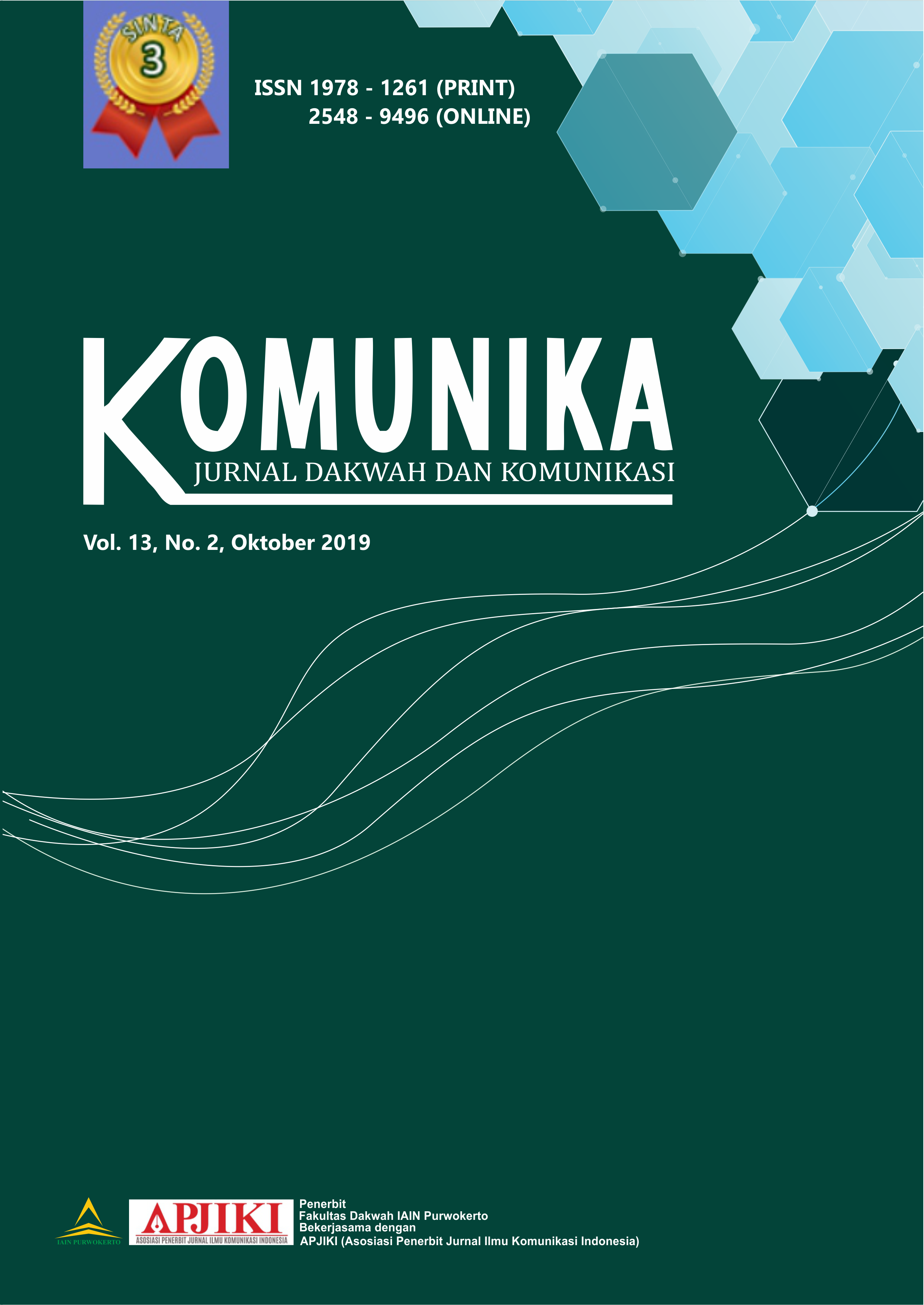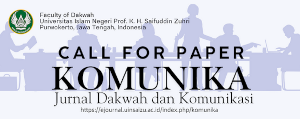Participatory Culture: A Study On Bangtan Boys Fandom Indonesia
DOI:
https://doi.org/10.24090/komunika.v13i2.2539Keywords:
Cultural Studies, Fandom, Participatory Culture, Korean Pop, BTSAbstract
In the past few years, South Korean pop culture has become a global phenomenon. The sudden popularity of the culture commonly known as as Korean Wave or Hallyu. This trend includes Korean drama, dance, music, films, animation, games, and fans club for Korean pop celebrity. In the past, those who become fans is only from a spesific age, but now it is more varied. One of most popular of the Korean singer groups is BangTan Boys. Abbreviated as BTS, the fans of BangTan Boys is proudly call themselves, “ARMYâ€. Using the Henry Jenkins’s Participatory culture theory along with qualitative method, this research tries to analyze that there are audiens who do not only consuming pop culture, but also producing new cultural artefacts from that. The data were collected by focus group discussion, in-depth interview and data analysis. It shows that some of the fans are making “fanfiction†as the reproductions of new artefacts, despite actively participating in BTS fandom by doing activities as include in the four types of Jenkin’s participatory cultures.Downloads
Download data is not yet available.
References
Baxter, L. A. & E. R. B. (2004). The Basics of Communication Research (with InfoTrac) (Wadsworth Series in Speech Communication) 1st Edition.
Bennet, L. (2012). Patterns of listening through social media: online fan engagement with the live music experience. https://doi.org///doi.org/10.1080/10350330.2012.731897
Brown, A. P. (Ed.). (1998). Identity and Fandom in Football. Routledge. London.
Cho, Y. (2011). Desperately Seeking East Asia Amidst the Popularity of South Korean Pop Culture in Asia. Cultural Studies, 25(3), 383–404. https://doi.org/DOI: 10.1080/09502386.2010.545424
De Lopes, M. I. V. (2012). A case study on transmedia reception: Fandom on Facebook and social issues in the Brazilian telenovela Passione.
Duffett, M. (2015). Understanding fandom: An introduction to the study of media fan culture. New York: Bloomsbury Academic.
Gooch, B. (2008). The Communication of Fan Culture: The Impact of New Media on Science Fiction and Fantasy Fandom. New Media on Science Fiction.
Heryanto, A. (2014). Identity and Pleasure: The Politics of Indonesian Screen Culture. Kyoto: Kyoto University Press.
Heryanto, Ariel. (2012). Budaya Populer di Indonesia: Mencairnya Identitas Pasca Orde Baru. Yogyakarta: Jalasutra.
Highfield, T. et al. (2013). Twitter as a technology for audiencing and fandom. Retrieved from https://doi.org/10.1080/1369118X.2012.756053
Hillman, S., & and Carman Neustaedter, J. P. (2014). Proceeding in SIGCHI. ‘alksjdf;lksfd’: Tumblr and the Fandom User Experience. 2014. School of Interactive Arts and. Technology, Simon Fraser University.
Jenkins, H. (2006). Convergence Culture: Where Old and New Media Collide. New York: New York University.
Jung, S. K. -po. (2011). Indonesian fandom, and social media | Jung | Transformative Works and Cultures. Source: Transformative Works & Cultures, .Vol. 8, p, 1.
Jung, S., & Shim, D. (2006). Social distribution: K-pop fan practices in Indonesia and the ‘Gangnam Style’ phenomenon. International Journal of Cultural Studies, 2014(17), 485–501.
Larasati, D. (2017). Arnindita (Vol. 3). Vol. 3.
Lee, H.-K. (2011). Participatory media fandom: A case study of anime fansubbing.
Lewis. (1992). Lisa A (Ed). The Adoring Audience : A Fan Culture and Popular Media. London: Routledge.
Lindlof, T. R., Taylor, & B. (1995). Qualitative Communication Research Methods. Sage Publication.
Bennet, L. (2012). Patterns of listening through social media: online fan engagement with the live music experience. https://doi.org///doi.org/10.1080/10350330.2012.731897
Brown, A. P. (Ed.). (1998). Identity and Fandom in Football. Routledge. London.
Cho, Y. (2011). Desperately Seeking East Asia Amidst the Popularity of South Korean Pop Culture in Asia. Cultural Studies, 25(3), 383–404. https://doi.org/DOI: 10.1080/09502386.2010.545424
De Lopes, M. I. V. (2012). A case study on transmedia reception: Fandom on Facebook and social issues in the Brazilian telenovela Passione.
Duffett, M. (2015). Understanding fandom: An introduction to the study of media fan culture. New York: Bloomsbury Academic.
Gooch, B. (2008). The Communication of Fan Culture: The Impact of New Media on Science Fiction and Fantasy Fandom. New Media on Science Fiction.
Heryanto, A. (2014). Identity and Pleasure: The Politics of Indonesian Screen Culture. Kyoto: Kyoto University Press.
Heryanto, Ariel. (2012). Budaya Populer di Indonesia: Mencairnya Identitas Pasca Orde Baru. Yogyakarta: Jalasutra.
Highfield, T. et al. (2013). Twitter as a technology for audiencing and fandom. Retrieved from https://doi.org/10.1080/1369118X.2012.756053
Hillman, S., & and Carman Neustaedter, J. P. (2014). Proceeding in SIGCHI. ‘alksjdf;lksfd’: Tumblr and the Fandom User Experience. 2014. School of Interactive Arts and. Technology, Simon Fraser University.
Jenkins, H. (2006). Convergence Culture: Where Old and New Media Collide. New York: New York University.
Jung, S. K. -po. (2011). Indonesian fandom, and social media | Jung | Transformative Works and Cultures. Source: Transformative Works & Cultures, .Vol. 8, p, 1.
Jung, S., & Shim, D. (2006). Social distribution: K-pop fan practices in Indonesia and the ‘Gangnam Style’ phenomenon. International Journal of Cultural Studies, 2014(17), 485–501.
Larasati, D. (2017). Arnindita (Vol. 3). Vol. 3.
Lee, H.-K. (2011). Participatory media fandom: A case study of anime fansubbing.
Lewis. (1992). Lisa A (Ed). The Adoring Audience : A Fan Culture and Popular Media. London: Routledge.
Lindlof, T. R., Taylor, & B. (1995). Qualitative Communication Research Methods. Sage Publication.
Downloads
Published
2019-09-30
Issue
Section
Articles
License
Authors who publish with this journal agree to the following terms:
- Authors retain copyright and grant the journal right of first publication with the work simultaneously licensed under a Creative Commons Attribution-ShareAlike 4.0 International License that allows others to share the work with an acknowledgement of the work's authorship and initial publication in this journal.
- Authors are able to enter into separate, additional contractual arrangements for the non-exclusive distribution of the journal's published version of the work (e.g., post it to an institutional repository or publish it in a book), with an acknowledgement of its initial publication in this journal.
- Authors are permitted and encouraged to post their work online (e.g., in institutional repositories or on their website) prior to and during the submission process, as it can lead to productive exchanges, as well as earlier and greater citation of published work (See The Effect of Open Access).

























